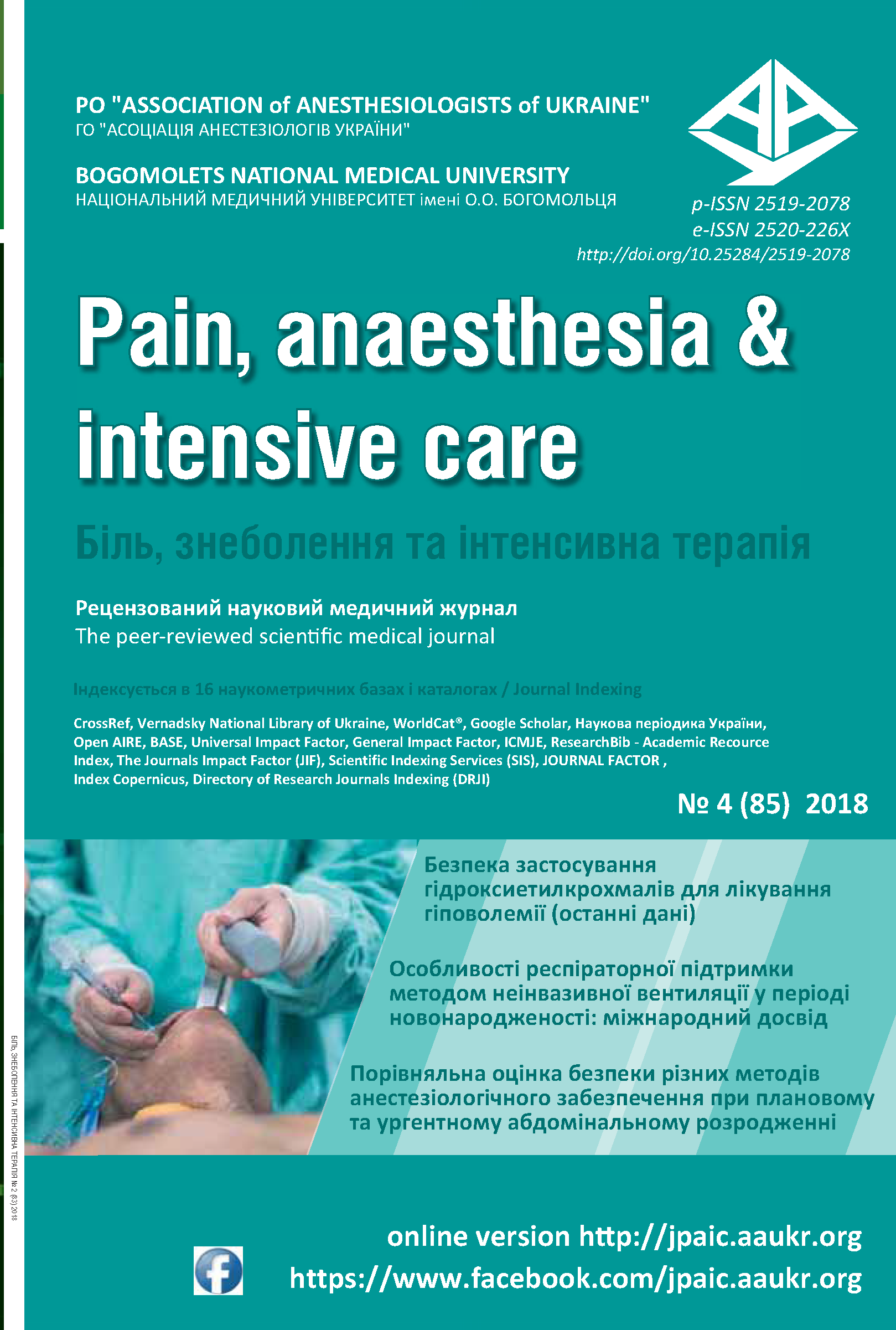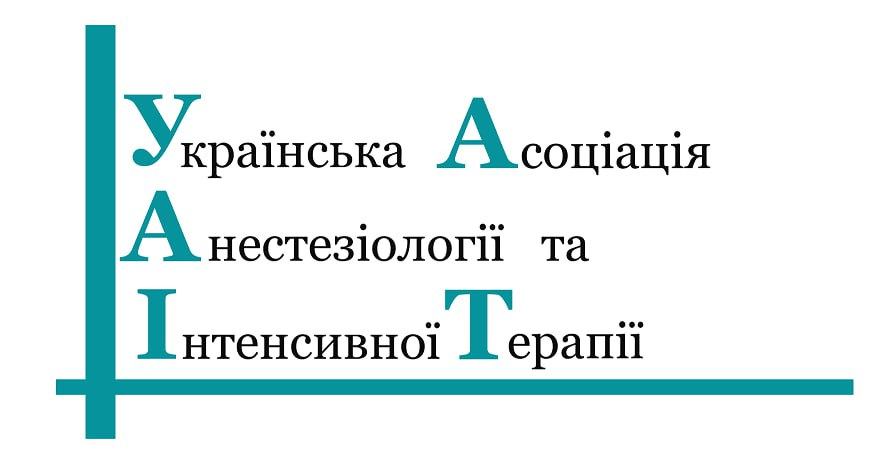Профілактика ускладнень інфузійної терапії в комплексі інтенсивної терапії політравми
DOI:
https://doi.org/10.25284/2519-2078.4(85).2018.151465Ключові слова:
безпека інфузійної терапії, ризики та профілактика, критичний станАнотація
В статті висвітлюється аналіз літератури щодо актуального питання безпеки медичних працівників при проведенні інфузійної терапії в комплексі інтенсивної терапії політравми. Визначені фактори ризику інфузійної терапії, зокрема високий ризик професійного впливу крові, що може призвести до передачі збудників, які спричиняють розвиток небезпечних інфекцій для здоров'я медичних працівників на всіх етапах надання медичної допомоги постраждалим з травмою. Наведено методи профілактики ризиків, пов'язаних з інфузійною терапією. Обґрунтовано необхідність використання профілактичних стратегій попередження виникнення гострих травм, нанесених пошкодженнями шкіри, які викликані гострими інструментами (голки, ланцет, скальпелі та розбите скло) та аваріями в медичній обстановці. Доведено, що застосування захищених аксесуарів, замість незахищених звичайних пристроїв, може призводити до значного зменшення ризиків. Показано, що контроль та корекція значної кількості інфузії у пацієнтів з політравмою потребує спеціального безпечного та зручного набору для інфузії.
Посилання
Injuries and violence: the facts 2014 / World Health Organization, 2014 // джерело http://apps.who.int/iris/bitstream/10665/149798/1/9789241508018_eng.pdf.
Critical care considerations in the management of the trauma patient following initial resuscitation / R.F. Shere-Wolfe, S.M. Galvagno, T.E. Grissom // Scandinavian Journal of Trauma, Resuscitation and Emergency Medicine. –2012. –20. –Р. 68. doi: 10.1186/1757-7241-20-68.
 |
|  |
| 
Josephson DL. Risks, complications, and adverse reactions associated with intravenous infusion therapy. In: Josephson DL. Intravenous infusion therapy for medical assistants. The American association of Medical Assistants. Clifton Park: Thomson Delmar Learning 2006; 56-82
Royal College of Nursing (RCN). Standards for infusion therapy. Third edition. The RCN IV Therapy Forum. http://www.rcn.org.uk/__data/assets/pdf_file/0005/78593/002179.pdf, January 2010
Jaeger R.J. Contamination of blood stored in plastic packs / R.J. Jaeger, R.J. Rubin // The Lancet. –1970. –2. –P.151.
 |
|  |
| 
Потенциальный риск для здоров'я фталатных пластификаторов поливинилхлорида (современные аспекты) / Г.М. Балан, Т.Ф. Харченко, В.Н. Левицкая, С.С. Ісаева, О.А. Харченко, Н.Н. Бубало, Л.И. Повякель // СУЧАСНІ ПРОБЛЕМИ ТОКСИКОЛОГІЇ 1}2/2013. –38-47.
Perdue MB. Intravenous complications. In: Perucca R. Infusion therapy equipment: types of infusion therapy equipment. In: Infusion therapy in clinical practise. Philadelphia: Saunders 2001; 418-445
Wittenberg AG. Venous Air Embolism. Emedicine, last updated: May 2006 Mirski MA, Lele AV, et al. Diagnosis and treatment of vascular air embolism. Anesthesiology 2007; 106(1): 164-77
 |
|  |
| 
Kuramoto K, Shoji T, Nakagawa Y. Usefulness of the final filter of the IV infusion set in intravenous administration of drugs –contamination of injection preparations by insoluble microparticles and its causes. Yakugaku Zasshi 2006; 126(4): 289-95
 |
|  |
| 
Preston ST, Hegadoren K. Glass contamination in parenterally administered medication. J Adv Nurs 2004; 48(3): 266-70
 |
|  |
| 
Lye ST, Hwang NC. Glass particle contamination: is it here to stay? Anaesthesia 2003; 58(1): 93-4
 |
|  |
| 
Puntis JW, Wilkins KM, Ball PA, Rushton DI and Booth IW. Hazards of parenteral treatment: do particles count? Arch Dis Child 1992; 67(12): 1475-7
 |
|  |
| 
Turco SJ, Davis NM. Detrimental effects of particulate matter on the pulmonary circulation. JAMA 1971; 217(1): 81-2
 |
|  |
| 
Jack T, Boehne M, et al. In-line filtration reduces the incidence of SIRS in critically ill children. Poster presentation, ISICEM 2009
 |
| 
Oie S, Kamiya A. Particulate and microbial contamination in in-use admixed parenteral nutrition solutions. Biol Pharm Bull 2005; 28(12): 2268-70
 |
|  |
| 
Anonymous. Risks due to particles in infusion therapy –experts promote use of infusion filters (Transl.: Gefahren durch Partikel in der Infusionstherapie –Experten fordern Einsatz von Infusionsfiltern). Krankenpfl J 2004; 42(3-4): 97
 |
| 
Safdar N, Maki DG. The pathogenesis of catheter-related bloodstream infection with noncuffed short-term central venous catheters. Intensive Care Med 2004; 30: 62-67
 |
| 
Raad I, Hanna H. Nosocomial infections related to use of intravascular devices inserted for long-term vascular access. In: Mayhall C, ed. Hospital Epidemiology and Infection Control. Philadelphia, Pa: Lippincott Williams & Wilkins; 1999: 165-172
Hall K, Farr B. Diagnosis and management of long-term central venous catheter infections. J Vasc Interv Radiol 2004; 15: 327-334
 |
| 
Uslusoy E., Mete S.: Predisposing factors to phlebitis in patients with peripheral intravenous catheters: a descriptive study. J Am Acad Nurse Pract. 2008; 20(4): 172-80
 |
| 
Bouchoucha et al. Deep venous thrombosis associated with acute hematogenous osteomyelitis in children. Orthop Traumatol Surg Res. 2010 Dec; 96(8): 890-3., Boucher 2010
 |
| 
Rello J, Ochagavia A, Sabanes E, Roque M, Mariscal D, Reynaga E, Valles J. Evaluation of Outcome of Intravenous Catheter-related Infections in Critically III Patients. Am J Respir Crit Care Med 2000 (162): 1027-1030
 |
| 
Jang TN, Lee SH, Huang CH, Lee CL, Chen WY. Risk factors and impact of nosocomial Acinetobacter baumannii bloodstream infections in the adult intesive care unit. A case-control study, received 16 January 2009; accepted 10 June 2009
Prьss-Ьstьn A, Rapiti E, Hutin Y. Estimation of the Global Burden of Disease attributable to Contaminated Sharps Injuries Among Health-Care Workers. Am J Ind Med 2005; 48: 482-490
 |
| 
Centers for Disease Control and Prevention. Workbook for Designing, Implementing, and Evaluating a Sharps Injury Prevention Program. 2008 www.cdc.gov/sharpssafety/pdf/sharpsworkbook_2008.pdf
Centers for Disease Control and Prevention. National Institute for Occupational Safety and Health (NIOSH). NIOSH Alert: Preventing Needlestick Injuries in Health Care Settings, 1999, Publication No.2000-108. (www.cdc.gov/niosh/2000-108.html)
Perry J, Parker G, Jagger J. EPINet Report: 2003 Percutaneous Injury Rates. Advances in Exposure Prevention 2003; 7: 42- 45
Fisman DN, Harris AD, Sorock GS, Mittleman MA. Sharps-Related Injuries in Health Care Workers: A Case-Crossover Study. Am J Med. 2003;114(8):688-694
 |
| 
Canadian Center for Occupational Health and Safety (CCOHS) Needlestick injuries. 2000. (www.ccohs.ca/oshanswers/diseases/needlestick_injuries.html)
Centers for Disease Control and Prevention. Workbook for Designing, Implementing and Evaluating a Sharps Injury Prevention Program. Update 2015
Yang L, Mullan B. Reducing needle stick injuries in healthcare occupations: an integrative review of the literature. ISRN Nurs. 2011;2011:315432. doi: 10.5402/2011/315432
Panlilio AL, Orelien JG, Srivastava PU, Jagger J, Cohn RD, Carco DM, the NaSH Surveillance Group; the EPINet Data Sharing Network. Estimate of the annual number of perc utaneous injurie s am ong hospital- based he althc are workers in the United States, 1997-1998. Infect Control Hosp Epidemiol 2004; 25(7): 556-562
 |
| 
Godfrey K. Sharp Practice. Nursing Times 2001; 97(2):22-24
 |
| 
Trim JC, Elliott TSJ. A review of sharp injuries and preventative strategies. J Hosp Infect 2003;53:237-242
 |
| 
Mason HJ, Morton J, Garfitt SJ, Iqbal S, Jones K. Cytotoxic drug contamination on the outside of vials delivered to a hospital pharmacy. Ann Occup Hyg 2003; 47(8): 681-685 DOI: 10.1093/annhyg/meg078
 |
| 
Schmaus G, Schierl R, Funck S. Monitoring surface contamination by anti-neoplastic drugs using gas chromatography-mass spectrometry and voltammetry. Am J Health Syst Pharm 2002; 59: 956-961
 |
| 
Kromhout H, Hoek F, Uitterhoeve R, Huijbers R, Overmars RF, Anzion R, Vermeulen R. Postulating a dermal pathway for exposure to antineoplastic drugs among hospital workers. Applying a conceptual model to the results of three workplace surveys. Ann Occup Hyg 2000; 44(7): 551-560
 |
| 
Fransman W, Vermeulen R, Kromhout H. Occupational dermal exposure to cyclophosphamide in Dutch hospitals: a pilot study. Ann Occup Hyg 2004; 48(3): 237-244 DOI: 10.1093/annhyg/meh017
 |
| 
National Cancer Institute website (USA). http://www.cancer.gov/aboutnci/servingpeople/CostOfCancer. Accessed Feb. 2010
ASTM. D6978-05: Standard Practice for Assessment of Resistance of Medical Gloves to Permeation by Chemotherapy Drugs, American Society for Testing and Materials 2005
Crauste-Manciet S, Sessink PMJ, Ferrari S, Jomier JY, Brossard D. Environmental Contamination with Cytotoxic Drugs in Healthcare Using Positive Air Pressure Isolators. Ann Occup Hyg 2005; 49(7): 619-628 DOI: 10.1093/annhyg/mei045
 |
| 
Tosini W., et al. Needlestick Injury Rates According to Different Types of Safety Engineered Devices: Results of a French Multicenter Study. Infect Control and Hosp Epidemiol April 2015; 31:402-407.)
 |
| 
Wicker S, Stirn AV, Rabenau HF, von Gierke L, Wutzler S, Stephan C. Needlestick injuries: causes, preventability and psychological impact. Infection. 2014 Jun;42(3):549-52
 |
| 
World Health Organization. Practical Guidelines for Infection Control in Health Care Facilities. SEARO Regional Publication No. 41, WPRO Regional Publication 2004
Centers for Disease Control and Prevention (CDC).Guideline for the Prevention of Intravascular Catheter-Related Infections. 2011
MMWR Morbitity and Mortality Weekly Report. Guideline for Hand Hygiene in Health-Care Settings. Recommendations of the Healthcare Infection Control Practices Advisory Committee and the HICPAC/SHEA/APIC/IDSA Hand Hygiene Task Force. Recommendations and Reports, Oct 25, 2002, (51) No. RR-16
##submission.downloads##
Опубліковано
Як цитувати
Номер
Розділ
Ліцензія
Авторське право (c) 2018 Біль, знеболення та інтенсивна терапія

Ця робота ліцензується відповідно до Creative Commons Attribution-NonCommercial 4.0 International License.
Автори, які публікуються у цьому журналі, погоджуються з наступними умовами:
a. Автори залишають за собою право на авторство своєї роботи та передають журналу право першої публікації цієї роботи на умовах ліцензії Creative Commons Attribution-NonCommercial 4.0 International License, котра дозволяє іншим особам вільно розповсюджувати опубліковану роботу з обов'язковим посиланням на авторів оригінальної роботи та першу публікацію роботи у цьому журналі.
b. Автори мають право укладати самостійні додаткові угоди щодо неексклюзивного розповсюдження роботи у тому вигляді, в якому вона була опублікована цим журналом (наприклад, розміщувати роботу в електронному сховищі установи або публікувати у складі монографії), за умови збереження посилання на першу публікацію роботи у цьому журналі.
c. Політика журналу дозволяє і заохочує розміщення авторами в мережі Інтернет (наприклад, у сховищах установ або на особистих веб-сайтах) рукопису роботи, як до подання цього рукопису до редакції, так і під час його редакційного опрацювання, оскільки це сприяє виникненню продуктивної наукової дискусії та позитивно позначається на оперативності та динаміці цитування опублікованої роботи (див. The Effect of Open Access).








